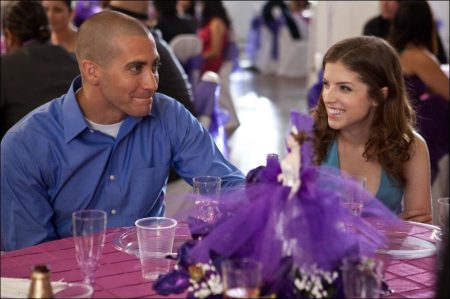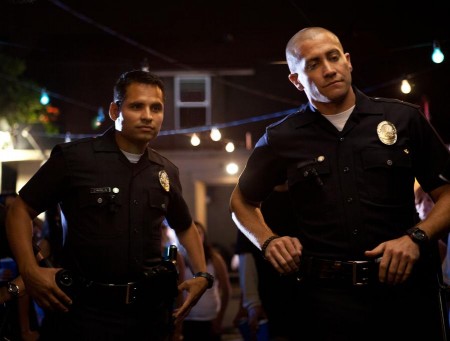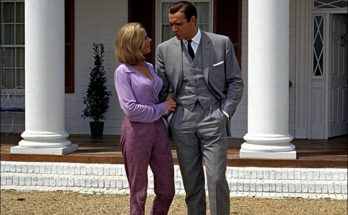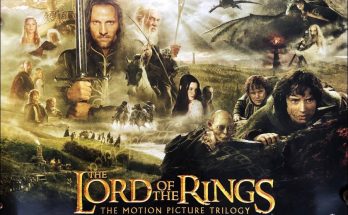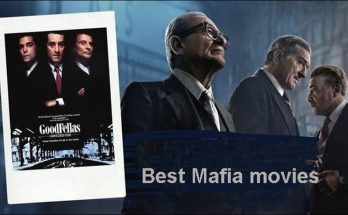Ayer’s re-entry into the Los Angeles cop genre. In their mission to abide by their oath to serve and protect, Officer Brian Taylor (Jake Gyllenhaal) and Officer Mike Zavala (Michael Peña) have formed a powerful brotherhood to ensure they both go home at the End of Watch. The only guarantee for these officers is that there are no guarantees when patrolling the streets of South Central, Los Angeles.
Between the blue lights, blaring sirens and adrenaline pumping action thrives an honest and often humorous banter between partners who spend most of their days in a police car awaiting the next call. The officers have formed a bond that allows them to function as a unit in the face of danger, knowing full well, at any moment, they could be called on to lay down their lives.
The vivid action unfolds entirely through footage of handheld cameras shot from the point of view of police officers, gang members, surveillance cameras, dash cams, and citizens caught in the line of fire. This 360° perspective creates a riveting and immediate portrait of the city’s darkest, most violent streets and back alleys, and the brave men and women patrolling them.
Writer / Director / Producer David Ayer (TRAINING DAY) was driven to get the story of Los Angeles cops “right,” and open a window into a rarely seen world of law enforcement for all its truth, grit and compassion.
About the Production
Growing up on the streets of South Central Los Angeles, life could have turned out very differently for writer / director David Ayer. He saw a neighborhood ripped apart by gang violence. Instead of contributing to it, Ayer began channeling those experiences into stories while serving in the U.S. Navy. His stories began to take shape and eventually formed screenplays such as the acclaimed film, Training Day.
“To go from Training Day to End of Watch is in a lot of ways, to complete a circle,” says Ayer. “Something about writing cops is easy for me. I have the ‘I-can-write-about-cops’ gene.”
With a string of cop films following Training Day, including S.W.A.T. and Street Kings, Ayer was concerned with typecasting in Hollywood and began to avoid the genre for some time. “It was pretty clear that I was headed down a certain road here,” said Ayer. “But one of my mentors (acclaimed screenwriter Wesley Strick) in the business told me to find my niche and exploit it. So that’s when I said, I know this— I’ve got to get back to this.”
But this time, Ayer would take a much different approach. Being friends with many men in law enforcement, he was looking to tell “their story.” While his previous works centered on gangster cops or corrupt cops, this script would center on what the real job was like.
“The thing about the cop genre— we haven’t seen what they really do at work,” says Ayer. “We’ve seen what Hollywood thinks they do. We’ve seen every other cop movie… where you gotta have the scene where two cops argue about jurisdiction.”
In past interviews, Ayer himself has said stories about corrupt officers are the most interesting subjects for cop films. END OF WATCH has made him rethink those earlier sentiments. “I’ve finally proved to myself that’s not true,” said Ayer. “And I think I proved to other people, that that’s not true.” For Ayer, the danger of everyday police work, coupled with “having to go home and have a normal relationship” with your significant other, was his way in.
“These guys see mayhem and carnage and are faced with incredible psychologically destructive situations, and then they have to go home and put work into a relationship,” says Ayer. “Somebody who can do that successfully to me is a fascinating person.”
Ayer’s re-entry into the Los Angeles cop genre was his script for END OF WATCH, which he wrote in six days. Ayer brought forward all of the skills he learned over the years to tell a very traditional story— one that had not been fully told before. “I wanted to capture the story of guys that go out there, work hard, do their job, and are fundamentally good people,” said Ayer. “What we’ve been trained to expect from a cop film is not going to be met in this movie. It’s the reality of it. It’s the boredom of it. It’s how people connect, how cops connect to each other. So this is really about being let into a secret world.”
Ayer’s approach to take all of the clichés of cop films and upend them, attracted producer, John Lesher to the project. “What I thought was really special about Ayer’s script was that it wasn’t a typical cop film, or a corrupt cop movie,” said Lesher. “It was really the story of two best friends and what they go through on the police force. The film has its action and violence, but it’s ultimately a story about friendship, family and those universal themes that resonate with everyone.”
Producers Nigel Sinclair and Matt Jackson were both drawn to the film after reading the script and reached out to Lesher to meet and discuss the project. Sinclair and Jackson signed on the make the film, without really knowing who the cast was, which was rare for an independent finance company. “We called Lesher back the next day after our meeting and said we’d make the film. Within 24 hours thereafter Gyllenhaal who had had read the script unbeknownst to us, committed to the film overnight,” said Sinclair. “That was a fortunate twist of fate .”
“Nigel and I were passionate about realizing the script from the pages, and discovering David Ayer’s vision and why this film was unusual,” said Jackson. “David was telling a story that was more about the camaraderie between two officers and points of view that capture an inside, visceral and exciting perspective.”
“This film isn’t really about two cops—it’s about two guys who to go to work, put on a police uniform and they become those people that we all see on the street,” said Sinclair. “And in South Central Los Angeles, they are confronted with terrifying and dangerous situations sometimes for a defining part of their day. So in the film you see these young men at work and in their family settings, and it’s that contrast which gives the movie its power.”
As the police technical advisor on the film and a former fifteen year veteran of the LAPD, Jaime FitzSimons appreciated Ayer’s quest to tell an accurate story. “I think the way this film is being shot and the way David has written it—both police officers and people in the community are going to see it and think, ‘Finally,’” said FitzSimons. “Finally, somebody has shown both sides of the equation of what it’s like to live in a community like this and what it’s like for two officers that are best friends to police a community like this. Ayer really gets into the significance of their partnership, and what it means for their loved ones and families, touching on all aspects of two police officers’ lives.”
The action of END OF WATCH unfolds like a documentary. Ayer developed the film to be extremely visceral with the viewer right in the middle of every scene. “I was really going after true point-of-view,” said Ayer. “I wanted it to be like watching YouTube—where something in your mind tells you this is real. This film is like YouTube meets Training Day in a lot of ways.”
Throughout filming, Ayer continually sequenced each shot so the audience is immersed deep within this world. For Ayer, END OF WATCH combined top notch production values with the real and visceral sense of YouTube. “I was attracted to Ayer’s ambition to give a truly authentic look at what it is like to be on the police force,” said Lesher. “His filmmaking techniques felt organic and like something we haven’t really seen before.”
From the relationship of the officers, to real-life locations to the extensive camera angles, authenticity was essential to the success of END OF WATCH. To make the action more immediate and immerse the viewer more fully, cameras filmed virtually 360° of the action. At any given time, there were four cameras rolling, including two cameras specially mounted to actors Jake Gyllenhaal and Michael Peña to underscore the realism of the scene. (Gyllenhaal’s character is taking a film course as part of his pre-law studies, and cameras are visible and organically woven into the storyline.)
“People are going to feel like they are working alongside Brian Taylor and Mike Zavala,” said technical advisor, Jaime FitzSimons. “They are going to feel like they are going for the ride— in the police aspect of this, in the partnership, and their outside relationships.”
The story begins with a heart-pumping car chase as Officer Brian Taylor (Jake Gyllenhaal) and Officer Mike Zavala (Michael Peña) are racing through the backstreets of the Newton jurisdiction of South Central Los Angeles attempting to catch a car full of gang-bangers, as a dash cam from Taylor and Zavala’s squad car captures every twist and turn of the chase. It ends in a barrage of bullets— one catches Taylor’s Kevlar vest— just another hazard of the job.
With each new dispatch comes uncertainty, a new set of challenges and an enormous rush for the two young officers: a local troublemaker has an altercation with a mailman;; a crack head “loses” her babies and Taylor and Zavala find them duct-taped in a closet;; they catch a “Mexican Cowboy” with a truck full of weapons and cash; they heroically save children from a burning building; they uncover a safe house for human trafficking;; and a routine check of an elderly woman’s home leads to a large narcotics seizure. At the end of every shift they mark down “EOW” on their log and head home.
A longtime “player” in the personal relationship department, Officer Taylor is now falling in love with the radiant Janet (Anna Kendrick) and Officer Zavala welcomes his first child into the world with his wife, Gabby, (Natalie Martinez). As they await their next call, the two men converse candidly about the risks of the job, and the rush and fear that comes with the territory. This is juxtaposed with relatable conversations about the women in their lives, and tender moments about their hopes for their families.
On the other side of the law, we are introduced to shadowy figures from the Sinaloa Drug Cartel and an LA street gang with names straight out of a graphic novel: Big Evil, Wicked, La La and Demon, among countless other “hoodrats and homies.” As the gang-bangers maneuver their way through the Southland, personal video cameras intimately capture them nihilistically wreaking havoc on the neighborhood.
“Technology has certainly changed police work. It’s absolutely normal now for cops to carry around video cameras, microphones, tape recorders,” said FitzSimons. “You see it on the gang side as well. Just look at YouTube. Gangs videotape everything now.”
Visits: 65
